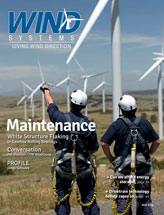We spend lots of time performing electrical troubleshooting at a wind farm. Let’s see if I can get you thinking about how you can improve your troubleshooting skills with a few tips and techniques.
To be a better troubleshooter, you should understand the theory of operation of your specific type of wind turbine. Understanding the specifics of your turbine’s operation will allow you to understand when it is not operating properly. Besides the basic theory of operation (of which we covered in magazine in the February 2013 issue of Wind Systems), you should know the theory of operation for: the cooling system, heating system, pitch system, braking system, yaw system, converter system, and any other subsystem or component within your turbine. You should understand your control system as to which parameters are adjustable and which are not. And you should be asking why it is that way.
Secondly, you should have a good understanding of electrical safety and of your electrical test equipment. Your main troubleshooting tool for electricity is your digital multimeter. You should have a sound understanding of its capabilities and it limitations. You should know how to check for voltage, current, and continuity. It goes without saying that you should always follow proper safety procedures and use your protective and safety gear properly. Another tool you should know how to use is your turbine’s electrical schematic. You should have knowledge of its specific protocols for identifying electrical components, how circuits continue from page to page, and how to identify the component and its location. The lines that indicate wires on your schematic may be short, but the actual wiring circuit could in fact run from down-tower to up-tower. If you are fairly new to the wind farm, you can probably gain some notes from your coworkers who have been on site for a while. A good technician will take time at the wind farm to get familiar with their specific equipment. These technicians will take the time to measure the resistance of that hydraulic solenoid valve and written its value of 450 ohms at its location on their schematic. He will have taken time to take a resistance reading of the windings of the yaw motor—recording this note to his troubleshooting notebook. He will know the value of the windings when it is connected in a wye connection and its individual winding values. You will know its resistive values between the windings and to ground. An experienced tech will know by testing what is an acceptable current draw value of every motor in the turbine. The information will be noted on his schematic or in his troubleshooting notebook. It is always smart to have handwritten diagrams and notes of a specific situation or holes dug for repairs. The same problem may show up again a year from now.
I would prefer my technicians to go out and look, listen, feel, and smell the turbines in the field during wind storms than to sit around the office catching up on paperwork. That’s the best time to learn how your machines run and operate. This focused observation will be valuable as the turbines age.
When it comes to troubleshooting electrical systems, some technicians get overwhelmed, especially if they have not had any formal troubleshooting training to help build these skills. Here are some tips that will help them.
Most electrical circuits are built the same way. The electrical circuits have components that do work for us. The type of work we ask electricity to do for us comes down to this: we ask for motion through magnetics; we ask for light through resistance; and we ask for heat through resistance. So, there are magnetic loads such as solenoid coils, relay and contactor coils, and motors and generators. We get light and heat typically through resistive loads. (LEDs and logic are not included here).
In addition to the items that we have do work for us, we have conductors—which are the wires. The wires get larger as we ask them to move more current for us.
We also have switches. The switches can be manually activated like a light switch on the wall. A switch can be activated by hydraulic pressure, by a low temperature or high temperature. A switch can be activated by a counter or a tachometer. A limit switch is activated by something reaching a predetermined limit. A float switch is activated by a liquid level. A switch can be activated by a magnet as in a relay or contactor. You get the point. Many things can activate a switch.
No matter what, in an electrical circuit on a wind turbine, there will always be just one load per circuit. Period. Only one item per circuit will do the work such as a motor, coil or resistor. Each load has its own circuit.
In that same circuit with the load there could be one switch, or a million switches. The switches could be wired in series with one another or in parallel with each other, or a combination of series and parallel. But for each circuit there will only be one load. If you know the value of the load in ohms, you can quickly see if it is defective.
I hope the tips help.





























